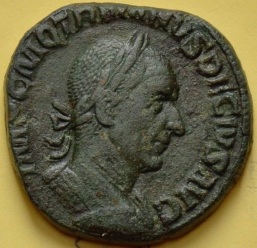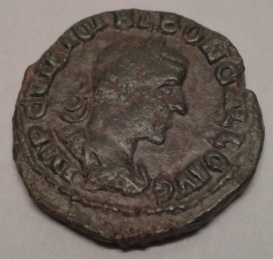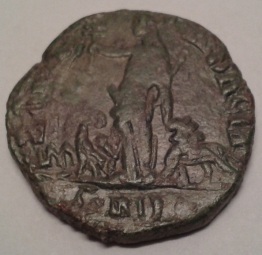HEAD OF WOLF – STANDARD OF THE DACIAN WARRIORS ON THE ROMAN COINS
Nicolae Sabin Dordea

Between Roman coins, one of the most popular coins issued in Dacia, in the name of Emperor Trajan Decius, is an antoninian which has on reverse the personification of the province (genius provincie) represented by a woman standing, facing left, with a specific apparel of Dacian women (with long chiton and pileus) and she keeps in his right hand an ensign of Dacia, the Dacian standard with wolf head. Around the person on the coin is inscribed the legend: DACIA. The sales sites, describing the Dacian standard on reverse of this coin, instead of „wolf head” occurs frequently and totally wrong „donkey’s head.” Of course that’s not hurting anyone, but this description causes, at best, indulgent smiles, if not disapproval.

Antoninian, Traian Decius, Dacia, Dacian standard with wolf head


Sesterces emitted by the Senate on behalf of Trajan Decius, also bears on the reverse personification of Dacia standing, facing left, wearing specific Dacian women and upholding in the right hand Dacia badge, Dacian banner with wolf head; legend: DACIA and SC (Senatus consult) in the field of coin.

It is true that some coins, this wolf’s head is not very successful, often resembles the head of a camel, horse or donkey (see coin above), but it does not allow us to look at things in a superficial way, it does not justify ignoring the historical reality. For accurate information on this symbol in the history of Dacians, we feel ought to make a brief clarification accompanied by clear evidence and arguments. The error occurred in the Dictionary of Roman coins, published in London 127 years ago and was perpetuated until today (Dictionary Of Roman Coins, Seth William Stevenson, London 1889). On page 663, the dictionary describes very nice and fair reverse of colonial coins strucked in Dacia, which quotes the work of renowned numismatists Jan Havercamp and Vaillant < „Dacia was the second province (Moesia was the first) that struck a medal in honour of Philip. It is dated of the year I. The type consists of a figure standing, clothed after the manner of the Dacians, and representing the genius of that province. She holds a Dacian sword in the right and a standard in the left hand, on which is marked the number XIII.” Vaillant, with its colonial coins, gives a medal of Aemilianus, with Provincia Dacia, AN VII, and female figure holding an ensign marked XIII, and a number V being in the field of the coin. “The numbers (says Havercamp) signify that the veterans of the fifth legion, called Macedonica, and of the thirteenth, called Gemina, had been placed in the province of Dacia by the Emperor Philip. These legions, from the time of Trajan, were almost always stationed in that province.”> Another accurate description: ” But on the colonial imperial coins of Dacia in general, from Philip to Gallienus, the province is represented as follows: A woman, adorned with the pileus, and wearing a sort of tunic and long cloak, stand holding in each hand a military ensign. On the velum, or small flag, of the right hand is the numeral V; on that of the left, the numeral XIII. On others the woman bears in her right hand a curved sword, peculiar to the inhabitants of the country;” But here below, the scholars do a confusion. On page 664, where the dictionary describes the reverse of coins issued under the emperor Gallus, is a big error: „On a very rare second brass inscribed to Trebonianus Gallus, the female figure holds in her right hand a branch; and in her left a staff, on the top of wich is an ass’s head.” – (Right as „a wolf’s head „- n.r.). In the incriminated text there are actually two confusion. First, and most regrettable is that Dacian banner was actually a wolf’s head and not an ass’s head. The second confusion is the fact that the text describes the reverses amalgamated of two different monetary types issued in the name of emperors Trajan Decius and Trebonianus Gallus. The reality is this: colonial coins with a particular monetary type that were issued in the province of Dacia, mint of roman colony Ulpia Traiana Sarmizegetusa, really have to reverse a female figure who holds in her right hand an olive branch, but in her left hand she has a scepter or a parazonium, not a standard. Monetary type in question was first issued in the name of Decius and only later in name of Gallus.


The first part of the sentence refers to colonial coins, whereas the second part of the sentence refers to imperial coins issued by the Senate or the Emperor Decius (shown at top), on the reverse of which the female figure holds in her right hand the sign of Dacia, the standard with head wolf. The error is repeated below, on the same page of the dictionary, where it describes the reverse of coins Imperial issued by Emperor Trajan Decius or Roman Senate: ” The figure in question bears in her left hand a tall staff, on which is placed the head of an ass, seemingly as thongh it were national ensign, as be observed on coins of Traianus Decius struck by the Senate; likewise on the silver mint of that emperor.” The entire text shows that these errors and confusion were taken in Dictionary from Vaillant. The information was taken by numismatists or dealers in this wrong form, without being filtered. I have seen on websites accurate descriptions made by people with knowledge, but the vast majority are simply vendors, whose primary goal is to sell, leaving the background or totally ignoring the history education.
To demonstrate the historical truth, we step back in time. Even during the reign of king Burebista (82- 44 BC) the Dacians were perceived as a threat to the Roman Empire. Caesar had planned a campaign against the Dacians, but her intention was frustrated by his assassination in 44 BC. After a century and a half, but before the age of Trajan, during the reign of roman Emperor Domitian, the legions of general Fuscus were defeated and the roman flags was captured by Dacians (87 AD) fact which created panic in Rome. During heavy wars waged by Emperor Trajan in Dacia (101-102 and 105-106 AD) fierce resistance and bravery of Dacians aroused admiration in the Roman world. The Dacian banner, the wolf head with snake body, called Draco (or Dracon), was a symbol of Dacian warriors. Built by the symbiosis of a wolf head with open mouth, continued with a serpentiform body – a dragon, was the fighting Dacian flag. Made of bronze or even silver, wolf’s head was stuck on a spear. Waving the banner if undulation have a metallic head and additionally produced a powerful hiss, which had the effect of encouraging Dacian warriors and panicking enemy fighters. Also, inducing nervousness for horses enemy who had never heard such a sound. The specific Dacian banner with wolf head is represented in several ancient monuments, the most famous representation of the Dacian flag being on Trajan’s Column in Rome. The cult of the Emperor Trajan considered a true god, it has resulted in raising monuments, sign of appreciation for his achievements in the expansion of the Roman Empire. One of them was built in Dacia, the present territory of Romania. It is Tropaeum Traiani, the triumphal monument of Traian at Adamclisi, built between 106-109 AD. to commemorate the victory of the Romans over the Dacians in 102 AD. The monuments which have withstood time, gives us more information about the ancient Dacians. The famous monument Trajan’s Column in Rome, erected in 113 AD., describes on the scenes immortalized in stone the whole story of roman wars against Dacians. The existence of Dacian standard is attested by the depictions on reliefs Column, especially in the fight scenes, around the Dacian fortresses or some chieftains among Dacians. In some cases, the representation of standard is related to the presence of king Decebal on Column, but it is also among the spoils of war from Dacia:

Dacian banner – detail from Trajan’s Column; The person on left is probably king Decebal On the pedestal of the monument, as war prey, along with the weapons are present the flags Dacian with wolf head, conquered by Romans in Dacia:



Representations of Dacian standards on the socket of Trajan’s Column – Rome
This ensign of Dacians or dragon banner with wolf head, was adopted after the Dacian wars, by the Roman army and it is known in Roman history as „draco”: „[ At the triumphal entry of Constantine the Great in Rome] gathered around draco (standards) tied to the tops of gilded spears and overlaid with stones bright, swollen by a great wind and thus whistling with anger, letting to flit the ample tails in the wind „- Ammianus Marcelinus, Rerum gestarum, 16,10,17 For the Romans the meaning “donkey head” was completely opposite the meaning “wolf head”. For the Romans at the beginning of the Christian era, the head of an ass was a sign of mockery. Therefore, if the banner carried by the Dacians as symbolized an ass’s head, we can say with certainty that the Romans would not be taken as a ensign of the Roman army or element in decorating monuments. In addition, the she-wolf has always been the symbol of Rome. On the eastern side of the People’s Square in Rome (Piazza del Popolo) to the Pincio hill and Villa Borghese park, there is a group of statues of the goddess Roma, flanked by two columns, each of them supporting a trophy weapons; above, in the background, on the terrace railing road, towering guard and calm, four statues of Dacians. Each of the two trophies of arms contains besides armor and weapons, two flags with wolf heads arranged side:

One of the two trophies of weapons of Piazza del Popolo in Rome which flanke the group of statues of the goddess Roma

English dictionary in 1889 which sparked the controversy is forgiven, because in the end of the brief chapter Dacia says about Dacian following: ” Although eventually compelled to give way before the strategic skill and superior discipline of the imperial legionaries, the Dacian people, both before and after their subjection to the Romans, shewed themselves to be Prodiga gens animae, studiisque asperrima belli „- People with a wonderful heart, concerned about the hardships of war.
